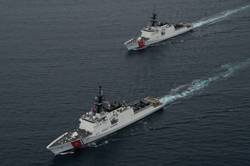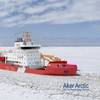USCG Works to Save Energy, Emissions
Alaris Companies last month announced it is working with the U.S. Coast Guard to help it decrease energy use and emissions via its fleet energy management program. Maritime Reporter recently visited with Alaris CEO, Bobbi Wolff, and Executive VP of Engineering, Michael Gaffney, to discuss the company, its system and the global trend to minimize maritime’s carbon footprint.
Alaris recently won a contract to help the U.S. Coast Guard decrease energy use and greenhouse gas emissions. Can you give us an overview of the vessels studied and the findings?
Wolff: We’ve assessed the in port operations for three classes of vessels for the U.S. Coast Guard: the National Security Cutters, the 225-ft Juniper Class and the 110-ft Island Class. Alaris is now beginning work on a new contract to assess the ships’ at sea operations as well. For the Juniper and Island Class Cutters in port operations we found a potential energy savings of 25 to 48%, largely through changes to heating and air conditioning.
Gaffney: On the National Security Cutters the main energy savings opportunities included securing equipment when it wasn’t required such as lighting and ventilation and changing set points for things like the hot water heaters and chill water systems. Some of the longer term items included installing energy recovery on the air conditioning system and using the available heat energy from the condenser for in port engine and potable water heating.
Wolff: Besides helping the Coast Guard to reduce its environmental impact and save on energy cost, we are helping the agency to prepare for the Ship Energy Efficiency Management Plan (SEEMP) requirement which goes into effect January 2013. Last July the IMO passed a resolution requiring vessel owners to establish a baseline of their current energy use and adopt a plan to move forward. Our audit and baseline report provides that starting point and the Energy Conservation Measures (ECMs) we identify are the path forward. The baseline and ECM reports contain the metrics companies or agencies can use to evaluate their progress on that path.
A reduction in energy consumption by 25 to 48 percent a year for the Juniper and Island Class vessels seems incredibly high. Can you expand upon the areas that were found for the biggest energy/emission savings?
Gaffney: The Juniper and Island Class vessels we assessed were in Alaska and the biggest consumer of energy on those ships is heating. These ships use strictly electric heating, which is resistive heating, and the least efficient form of energy for heat. We identified more efficient methods of heating, including heat pumps. Believe it or not, air conditioning is also one of the highest energy consumers on some of these vessels. One Coast Guard ship we assessed in Alaska was running their air conditioner all year. But the sea water is 44 degrees, so all they have to do is run the chill water loop through a heat exchanger and shut off the air conditioner all together. Another main consumer was the jacket water heating, which was set at a very high temperature. Savings could be realized by lowering that temperature to 110 degrees, peaking at 160. Other changes such as lighting and insulation also offered significant savings. In all, the potential for energy savings on these ships is, in fact, 25 to 48%.
We understand that EQUATE is your in-house energy modeling software program which provides predictions of energy consumption. Can you provide a brief description, in layman terms, as to how it actually works?
Wolff: With EQUATE we catalogue all of the energy consumers and producers on a ship (ship systems and equipment). Additionally, we catalogue all the different operational profiles (modes of operation) and the amount of time that is spent in these particular operational profiles. From that we build a model of the energy consumption per unit of useful work, by system, right down to a particular piece of equipment. Then we identify where there are inefficiencies and waste and we look for the places where the most energy is being consumed. We identify energy conservation measures, or ECMs, with the biggest bang for the buck. We use real data as far as the cost of fuel, cost of electricity, etc. We can analyze all that and tell the client how much energy they’re going to save, how much that equals in dollars saved and how much emissions will be reduced. With EQUATE, the owner can specify exactly what information they’re after. For example, they could say “I only want to know about ECMs that are going to have a full pay back period within two years and have a return on investment of at least 30%.” We’re able to specify certain criteria so the model will automatically spit out results that will tell them, for instance, what motors they should throw out right now and replace with higher efficiency units, and which ones they should wait to replace when they fail. Right now, most people don’t want to do things that aren’t going to pay for themselves within a couple of years.
Gaffney: One of the things that makes this model so powerful is its ability to look at different energy rates or energy costs. You can have one rate during the day on shore power and another rate at night. There may be one energy cost for operating on one generator and another for operating on two. The model allows us to catalogue the cost based on how many hours each piece of equipment runs at each energy rate or cost. The amount of emissions created by each piece of equipment also varies by engine load and depends on if you’re using shore power or ship’s power. We capture all these dynamic scenarios and quantify it and put real value on it in terms of energy usage, energy costs and emissions. It allows you to do what-if scenarios. What if you improved the efficiency of your engines and lowered your per kilowatt hour cost? What if you used ultra-low sulfur fuel all the time instead of switching back and forth? Here’s how much it would cost you based on your ship’s energy profile and operational tempo. Here’s the difference in emissions. We are not aware of any other model in the world that can do this.
Is EQUATE best suited to be utilized from the outset, at the design phase, or for existing vessels in service? (or does it matter)
Gaffney: It can be used at any phase and has been used for land-based facilities like terminals as well as for ships. The design phase is by far the most cost effective period to use EQUATE. It gives owners a financial basis on which to make technology decisions at the beginning of the vessel’s life. We build the model based on design data and what the ship is intended to do. We can tell a client, if you use a higher efficiency motor, here’s the maximum savings that you can attain in one year, based on the anticipated operational profile and anticipated load consumption.
Do you have any commercial marine case studies with the system?
Gaffney: We did an on board energy audit for Skaugen Petro Trans, Inc. (SPT) on a class of tankers and on one supply vessel. The supply boat was going to be repowered and SPT needed to understand where its current energy consumption was, both on the main engines and the auxiliaries. We went on board and measured all the auxiliary loads and came up with a set of ECMs that would allow the vessel to go from a 100Kw auxiliary engine down to a 40Kw auxiliary engine. On the main engine side, we attached temporary torque meters to the shaft and did T-trials to get a true understanding of the real power requirements. We found that they could use a smaller main engine as well. So the owner had a much smaller capital outlay for the repower and can now realize big savings on his annual energy bill at sea and in port.
On the tanker we took the same measurements on board and determined the most cost effective speed at which to transit, when possible. The auxiliary side of the tanker included a steam system used for unloading cargo for their large cargo pumps.
We discovered that if they optimized the boiler and pump load while discharging and only operated at certain discharge rates, they could save about $55,000 year or so — just from that one ECM. And the energy savings discovered for this one tanker were applicable to the entire class of SPT tankers.
Can you give a ballpark figure as to how much it costs for your energy and emission assessment using EQUATE, and some insights on the projected time frame for Return on Investment?
Wolff: It depends on the size of the ship and how much equipment is on board. An energy assessment with baseline and ECM report could range between $50,000 for a small vessel with few systems, to $500,000 for a large, complex vessel, such as a Navy ship. A complex, commercial ship, like a tanker, could run about $75,000. We have never done an assessment that did not have the potential to pay for itself in the first year. This includes the cost of implementing the energy management plan and making upgrades to equipment. Owners that have a number of vessels in the same class can use one assessment on a single vessel and apply it to the entire class.
Gaffney: There’s always a way to implement an energy management plan through a self-funding program. Operational changes often pay for the cost of the assessment and then some. The following year the company can put the annual cost savings into investing on equipment upgrades which will bring even greater savings, and so on.
(As published in the October 2011 edition of Maritime Reporter + Engineering News - www.marinelink.com)

















